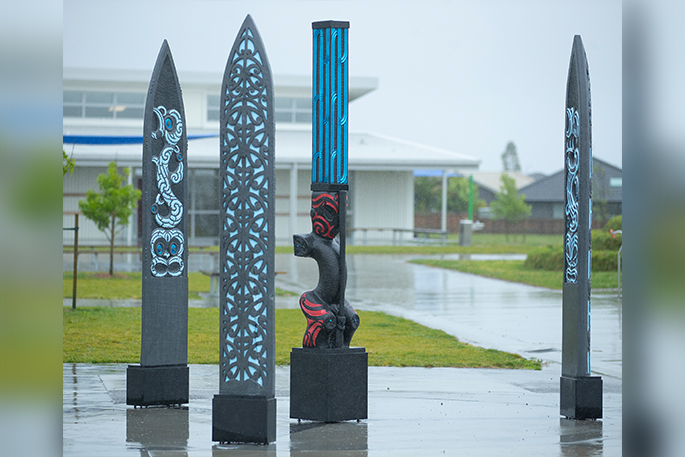A place of peace and inclusiveness is what four intricate carvings, sitting in the grounds of Te Manawa ō Pāpāmoa School, symbolise to students and the community.
“They are a visual representation of the narrative that this is a place for everybody,” says principal Shane Cunliffe, who was overjoyed to see the carvings – which were crafted by artist Whare Thompson – unveiled in a school celebration on October 31.
“The carvings symbolise the breaking of barriers and connecting people.”
The project all began with a discussion. “I sat with the school board as well as mana whenua and we had a hui [a consultation] around what the carvings could represent,” says Whare, the man behind the artwork.
“When they approached me they had a fair idea of what they were wanting. They were wanting three waka and a poutokomanawa [central post].
“I took on board what we talked about in terms of the representation of the school vision, the school values and the school logo,” says Whare.
The school logo represents three waka and the manawa (heart) that joins people. The school values are Ignite, Navigate and Thrive. The five school values are Manawa Taruna (Connected), Manawa Pākiki (Curious), Manawa Manaaki (Caring), Manawa Auaha (Creative), and Manawa Kaha (Courageous).
“I used each of the symbols in the logo to incorporate into the carving that represented the school’s vision and the three surface patterns. I incorporated the school vision at the top of each of the carvings,” Whare explains. The carvings “capture the aspirational vision for all within Te Manawa ō Pāpāmoa School, which recognises the journey of each individual towards growths, success and achievement”.
Shane says the carvings create a visual representation of the school’s localised curriculum, the historical significance and learning about their student community and identity.
Ngāti Ranginui, Waitaha, and Ngā Potiki iwi were all involved in the process making the carvings, which are significant for the Pāpāmoa area.
The three forms represent the Waka Tākitimu, Te Arawa and Mataatua of Tauranga Moana. “The waka have a strong connection to the past, present and future and protect and nurture learning that lies with the manawa [heart], a poutokomanawa represents mana whenua,” says Whare.
“The front of the waka is representing the school, the teachers and the students and then on the back of the carving we’ve got the representation of the captains and the high priests of each of those waka.”
“It helps to acknowledge mana whenua as well as the wider community that is represented on the top of the post,” says Whare. “It is all about inclusiveness.”

